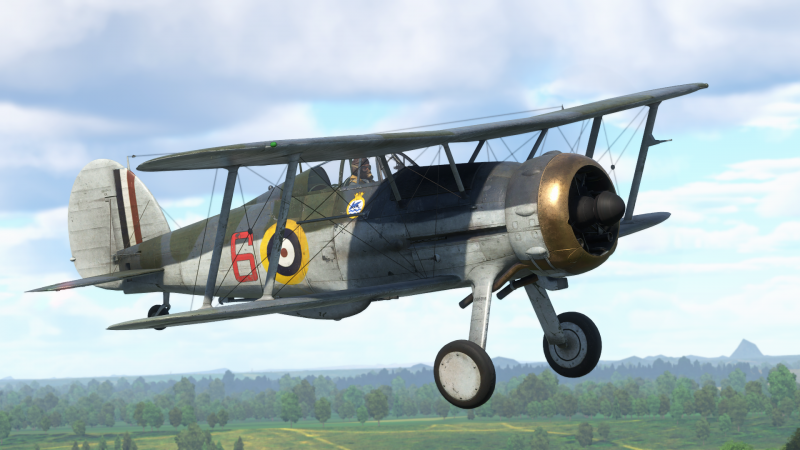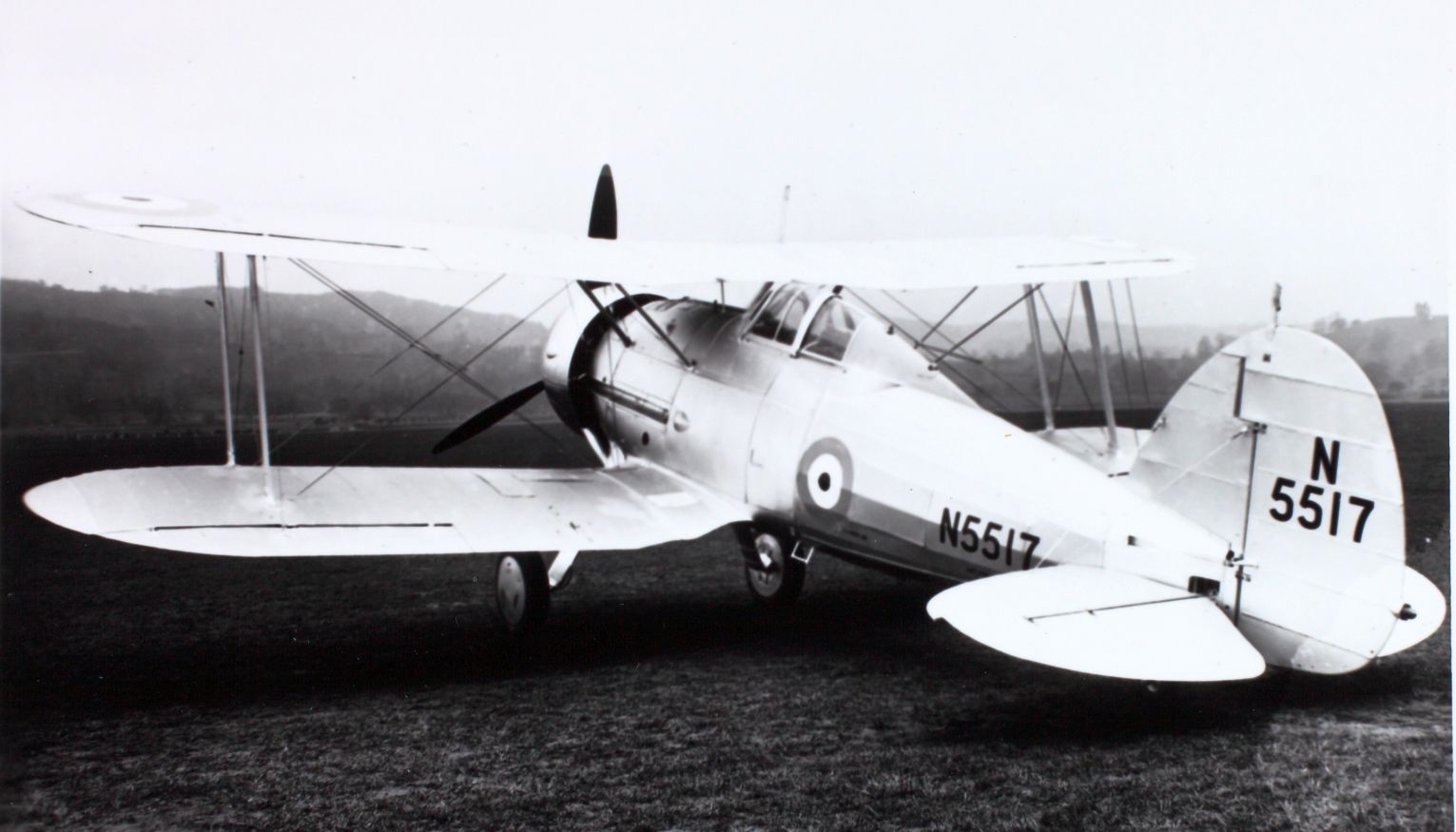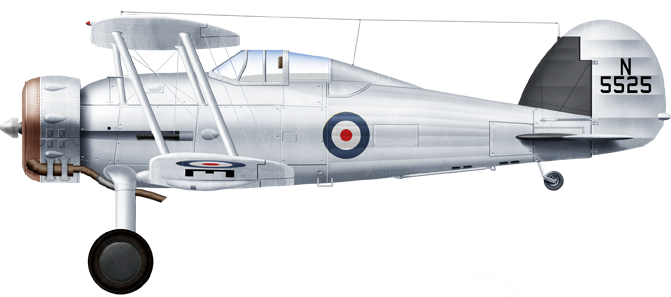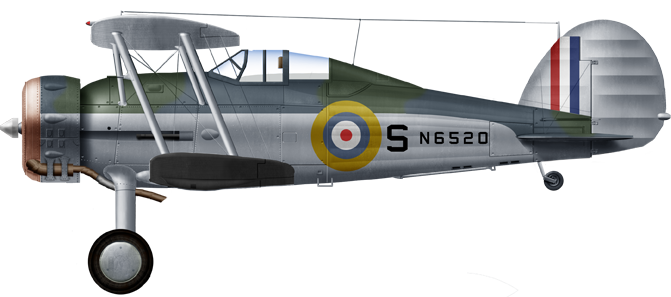
The Gloster Sea Gladiator was a naval variant of the Gloster Gladiator, a British biplane fighter aircraft that was used by the Royal Air Force (RAF) and the Fleet Air Arm during the late 1930s and early 1940s. The Sea Gladiator was specifically designed for operations on aircraft carriers.
Origins: The Sea Gladiator was derived from the land-based Gloster Gladiator, which was one of the last biplane fighters used by the RAF. The Gladiator itself was designed in the 1930s and was in service during the early years of World War II.
Naval Adaptations: To make the Gladiator suitable for carrier operations, certain modifications were made. These included the addition of an arrester hook for deck landings and the strengthening of the airframe to withstand the stresses of catapult launches.
Service History: The Sea Gladiator saw active service during the early years of World War II. Notably, it played a role in the defense of the British naval base at Malta during the Siege of Malta in 1940-1942.
Armament: Like the land-based Gladiator, the Sea Gladiator was armed with machine guns. Typically, it was equipped with four .303 inch (7.7 mm) Browning machine guns, two in each wing.
Performance: The Sea Gladiator had a top speed of around 253 mph (407 km/h) and a range of approximately 430 miles (692 km). Its performance was somewhat limited compared to more modern monoplane designs, but it still played a role in the early stages of the war.
Legacy: While the Sea Gladiator was eventually phased out of front-line service as more advanced aircraft became available, its contribution during the early war years, particularly in the defence of Malta, is remembered. The Gloster Sea Gladiator, like its land-based counterpart, represents the end of an era in military aviation, as it was one of the last biplanes used by the British military.
Development
Context
The roaring twenties saw a development of Britain’s air defences upon a new generation interceptor aircraft made for short ranges runs at 150 to 200 miles per hour (240 to 320 km/h), and still largely made of wood and canvas. In the thirties, the Air Ministry wanted to upgrade the concept, and wanted to distance themselves from the classic formula “one pilot, two machine guns” as the latter were often jamming and being generally unreliable in flight. The Air Ministry’s committee formulated Specification F.7/30, for a new interceptor rated at 250 mph (400 km/h) and four machine guns of a new type, with redundancy. Handling characteristics of the new fighter would also allow a pilot t be still comfortable in night squadrons. Gloster, already busy with the Gloster Gauntlet, skipped the specification, to return later with a better product for the next ones.
The controversial spec F.7/30 (1933)
The specification notably specified the new Rolls-Royce Goshawk liquid cooled inline engine and this all proposals received by various manufacturers featured the same Goshawk engine, which however on the long run, proved to be unreliable. To blame was its overly complex and underdeveloped cooling system, which did not fitted its purpose. In the end, its weight made the whole development of the early 1930s fighter stall. The machine gun breeches placement was also an issue, as it needed to be placed within arm’s reach of the pilot, contradicting the engine model in part. Development of monoplane fighters however also rose with some private ventures and foreign examples, and the early prototype of the Hawker Hurricane and Supermarine Spitfire eventually contributed to make the F.7/30 specification obsolete.
Gloster however still believed it could fill the need with the Specification F.7/30 and rather than starting on a blank page, submitted its Gauntlet, but worked on a development under private venture, the SS.37, with a team under legendary designer H.P. Folland, which ensured to meet the new specification. Gloster reused wing-design techniques developed by Hawker and used single-bay wings, not two-bay ones as the former fighter, removing also two pairs of interplane struts to reduce drag. The next point for performance was the upgrade to the Bristol Mercury M.E.30 radial rated for 700 hp (520 kW) and to complete the upgrade, a new cantilever main undercarriage with internally sprung wheel struts.
A private venture improved Gloster Gauntlet

The prototype of the Gloster Gladiator
This spring 1934, the first SS.37 prototype was started, completed in September 1934, for its maiden flight by chief test pilot Gerry Sayer. It had a lower grade 530 hp (400 kW) Mercury IV engine, and then, swapped for more flights to the 645 hp (481 kW) Mercury VIS, reaching 242 mph (389 km/h; 210 kn) with its four .303 in (7.7 mm) between the fuselage and lower wing. Submitted to the Air Ministry, they expressed doubt about meeting performances with a radial, but granted a trials session which started on 3 April 1935, with the RAF (K5200) whereas Gloster worked on an 840 hp (630 kW) Mercury IX engine upgrade with a new two-blade wooden fixed-pitch propeller, better wheel discs, fully enclosed cockpit. K5200 was later modified that way.
By June 1935, production was approved under Specification F.14/35 drawn up under rising tensions on continental Europe. The order of the day was a rapid expansion of the RAF with any model ready to specs, and there was a first order to Gloster for 23 aircraft, the model being named officially by 1 July 1935 the “Gladiator”. Production started at Hucclecote and on 16 February 1937, K6129 was accepted by the RAF, then 4 March 1937, K6151, last of the first batch. By September, 180 more were ordered with a schedule to the end of 1937.
Main production models: MkI, and MkII.
The Gladiator Mk I arrived in numbers from July 1936 and was in service by January 1937 and benefited of th discredit towred the Rolls-Royce Merlin combustion chamber. The Air Ministry then ordered 300 more Mk II Gladiators under the stopgap Specification F.36/37, with 252 to be delivered by April 1940. Gloster fitted the more powerful Mercury VIIIAS engine using Hobson mixture control boxes and half-automated boost-control carburettor plus the new Fairey fixed-pitch three-blade metal propeller, and four Browning 0.303-in machine guns under licence by BSA. Last British biplane fighter of WW2 it saw service until late 1942 on various fronts, excelling in particular in North Africa against Italian fighters. In all, with 747 built (483 RAF, 98 RN), 216 were exported to 13 countries (Belgium, China, Egypt, Finland, Free France, Greece, Iraq, Ireland, Latvia, Lithuania, Norway, Portugal, South Africa, Sweden) but stood no chance against the Messerschmitt Bf 109, zbout 150 kph faster.
The Sea Gladiator variant
Gloster initiative towards a marine version of its fighter was largely also a prinvate venture aimed towards Navy needs. Gloster started with the Mk II as a base, and named it the “Sea Gladiator”. It was proposed to the Fleet Air Arm in 1938. an arrestor hook, catapult attachment points, a strengthened airframe, and an underbelly fairing for a dinghy lifeboat, all for operations aboard aircraft carriers. Of the 98 aircraft built as, or converted to, Sea Gladiators, 54 were still in service by the outbreak of the Second World War.
At first the company produced the “Sea Gladiator Interim”, and early serie, this single-seat fighter biplane was created for the Royal Navy, from 38 modified Gladiator II aircraft, refitted with an arrestor hook. Their serial numbers were N2265 from N2302. The main Sea Gladiators were 60 Single-seat fighter biplane for the Royal Navy, 60 built. Fitted with arrestor hooks and provision for dinghy stowage. Serial numbers: N5500 – N5549 and N5565 – N5574.
Design
The Sea Gladiator was a repeat of the Gloster Gladiator design minus changes: Hook, reinforced drivetrain suspensions, parts of the structure altered or strengthened (like the wings and struts attachements), new airspeed indicator (ASI), TR.9 radio. The first batch arrived by December 1938, assigned to RNAS Worthy Down, Hampshire for instructor training and the rest in naval air stations/storage while pilots were trained. The main production contract was altered for 60 machines numbers N5500-N5549 and N5565-N5574 by June 1938. This time the order was backed by an official, full Admiralty specification F 26/37. They had link chutes to catch expended shell cases of the machine guns, and an underbelly fairing for a dinghy stowage, plus catapult attachment points, to round their navalization. The Gloster Sea Gladiator was built with a mixed structure, aluminium and wooden framing, covered with canvas at the rear, and full metal forward.
Many features came from the earlier Gloster Gauntlet, the wings composition and shape, tail and elevons, even the struts architecture were similar. But the greatest difference was the adoption of and enclosed cockpit to meet the required top speed of 242 mph (389 km/h; 210 kn) while carrying the required four .303 in (7.7 mm) machine guns, two synchronised Vickers guns (fuselage) and two Lewis guns (lower wing).
Engine
The Mark I Gladiator was to be initially fitted with the inline Rolls-Royce Merlin, but it had issues, in particular the combustion chamber. In order to not delay too much the production of next-generation fighters, the Air Ministry ordered 300 Mk II Gladiators under stopgap Specification F.36/37 fitted with the powerful Mercury VIIIAS engine, with Hobson mixture control boxes and half-automated boost-control carburettor. The propeller was a Fairey fixed-pitch three-blade metal model (no more the two-blade wooden one). The VIIIA was specifically fitted with gun synchronisation gear for the Gloster Gladiator MkII. Performances wises, the Sea Gladiator was heavier (3,745 lb versus 3,450 lb light and 5,420 lb vs. 4,750 lb. fully loaded) and thus, less agile than the land version, but still capable of 253 mph (407 km/h) with an initial Climb rate of 2,300 ft/min (700 m/min), a service Ceiling of 33,000 ft. (10,060m) and a range of 425 miles versus 440 on the land based one.
Armament
The initial two .303 in. Vickers in fuselage and two .303 in. Lewis guns under lower wings were replaced by a uniform set of four .303 cal Browning MGs on the samle locations, with above 1000 rounds. It could carry bombs, at least in theory. No attachment points were created or shown in photos.
⚙ Sea Gladiator Mark I specifications |
|
| Gross Weight | 3,730 lb empty |
| Max Takeoff weight | 5,400 lb loaded |
| Lenght | 27 ft 5 in |
| Wingspan | 32 ft 3 in |
| Height | 10 ft 4 in |
| Engine | 840 h.p. Bristol Mercury VIIIA radial |
| Top Speed, sea level | 244 mph at 14,500 ft |
| Range | 423 miles |
| Ceiling | 33,000 ft |
| Armament | Four .303 cal Browning MG |
| Crew | 1 pilot |
Service
Scotland and Norway
The Sea Gladiator was the last Royal Navy biplane fighter, assigned to the 801 Naval Air Squadron (NAS) on February 28, 1939, mostly busy with deck landing training, later reinforced by six new Sea Gladiators of the Mark I Interim type plus four Skuas, and in May became 769 NAS. The first real carrier trials started on HMS Courageous in March while 802 NAS (Lt Cdr J P G Bryant) was assigned to HMS Glorious. Before the war, this was the only proper fighter squadron of the FAA.
Combat debuts saw the RN fielding 54 Sea Gladiators, only nine with 802 NAS on Glorious, cruising in the Indian Ocean. To defend Scapa Flow, 804 NAS was formed at Hatston in Orkney Island, HMS Sparrowhawk base, in December (Lt Cdr John Cockburn). These Sea Gladiators flew almost daily against Luftwaffe incursions with a first “kill” at last on April 10, 1940. In the evening, an interception over Kirkwall and Hatston, with Lt Cdr Cockburn credited with one Heinkel He 111 and Lt Smeeton claiming one as “damaged”.
With Operation Weserübung, British and French support started with the arrival of RAF’s 263 Sqn with Gladiators ferried by HMS Glorious, having her Sea Gladiators of 802 NAS parked inside her hangar, under command of Lt. John Marmont plus those of 804 NAS. RAF Gladiators fought over Namsos from April 20 while Sea Gladiators from HMS Glorious were in the air daily to fend off Luftwaffe attacks. On April 27, they patrolled over Åndalsnes for the evacuation of the allies from central Norway. They spotted a lone He 111 of 1(F)/122 which was badly damaged by Richard Smeeton (804 NAS) and crash-landed near Trondheim. On May 1, Sea Gladiators intercepted several raids, one with six Junkers Ju 87Rs (2/StG 1), one down, N2276/H Marmont damaging another one.
The 263 Sqn was reequipped with Gladiator Mark.IIs to support northern Norway campaign, flown from HMS Furious, which featured six Sea Gladiators (804 NAS), departing on May 14 also with Hurricanes from 46 Sqn. By May 28 Sea Gladiators from 802 NAS shot down a Heinkel He 115 (2/KuFlGr 506). The Hurricanes were flown inland on May 26. On June 7, surviving RAF fighters returned on Glorious back to Scapa Flow, until sunk en route by Scharnhorst and Gneisenau. The whole 802 NAS, planes, pilots and personal went down with her.
Mediterranean
From June 10, 1940, Italy was at war with the allies, and France will soon capitulate; leaving the RN alone to deal with the Regia Marina. HMS Eagle was in the Mediterranean Fleet at the time, and having no fighters, was soon reinforced by four Sea Gladiators out of storage at RNAS Hal Far in Malta. On June 16 they started training under Cdr Charles Keighly-Peach, also training several Swordfish pilots in fighter tactics to provide cover. On July 11 and Italian flying boat was intercepted by not shot down. Later five Savoia-Marchetti S 79s were spotted and engaged, one shot down, but its return fire hit Keighly-Peach’s Sea Gladiator while he was wounded, abandoning his attack. Two days south of Crete these fighters had to fend off raids from the Aegean and Libya. A lone Savoia S 79 was splashed. Three hours later three Savoia TBs were intyercepted, one shot down, one badly damaged, and later a formation of tri-motor bombers (Savoia S 81s) had one more splashed.
On July 29 another S 79 was shot down, and in August during the shelling of Bardia, on the 17th there was a large Italian air raid, with all HMS Eagle’s Sea Gladiators scrambled. They were at the time ashore in Sidi Barrani, Egypt. One S 79 and perhaps two were damaged, not shot down. One RAF Gladiator made claims. In the end, four destroyed eight damaged. On August 31 they intercepted off Crete a lone Cant Z 506B at 6,000ft, third and final confirmed claim of Charles Keighly-Peach, now an ace and lead FAA pilot, awarded the DSO.
HMS Illustrious newt arrived with Fairey Fulmars so Eagle was no longer alone. On November 6, they flew to protect two heavily escorted convoys for Malta, Illustrious having two Sea Gladiators (Lt Cdr Charles Evans 806 NAS). They soon claimed a Cant Z.501 from 186a.
Jackie Sewell becale the secnd Sea Gladiator ace, with six, seven shared destroyed. On January 10, 1941 he flew to defend the Islands against Ju 87 Stukas savaging Illustrious. On January 24 he spotted a Ju 88 diving over Hal Far and shot it down. Surviving Sea Gladiators at that point were concentrated at RAF 261 Squadron, Malta used from there for meteorological reconnaissance only. In Egypt in March 1941, 805 NAS flown its Sea Gladiators alongside Buffalos and Fulmars over Crete. By June these were placed in second line and were fully retired as obsolete in 1942, with the arrival of the Sea Hurricane and enough Fulmars to equip all carriers.
Links and resources
on key.aero RN last biplane fighter
on britmodeller.com sea gladiator night fighters
warbirdsresourcegroup.org
en.wikipedia.org Gloster_Gladiator
The model corner
Gloster Sea Gladiator Mk.I/II Pavla Models | No. 72059b | 1:72, Roden | No. 405 | 1:48, Gloster Sea Gladiator “Malta Defender” Mark I Models No. MKM14455 1:144.
Gallery
Author’s illustrations: Types and liveries

802 NAS model based on HMS Glorious, Aboukir Air Force, Egypt, summer 1939

“Faith” in Hal Far base, Malta july 1940
Additional photos






 Latest Facebook Entry -
Latest Facebook Entry -  X(Tweeter) Naval Encyclopedia's deck archive
X(Tweeter) Naval Encyclopedia's deck archive Instagram (@navalencyc)
Instagram (@navalencyc)





 French Navy
French Navy Royal Navy
Royal Navy Russian Navy
Russian Navy Armada Espanola
Armada Espanola Austrian Navy
Austrian Navy K.u.K. Kriegsmarine
K.u.K. Kriegsmarine Dansk Marine
Dansk Marine Nautiko Hellenon
Nautiko Hellenon Koninklije Marine 1870
Koninklije Marine 1870 Marinha do Brasil
Marinha do Brasil Osmanlı Donanması
Osmanlı Donanması Marina Do Peru
Marina Do Peru Marinha do Portugal
Marinha do Portugal Regia Marina 1870
Regia Marina 1870 Nihhon Kaigun 1870
Nihhon Kaigun 1870 Preußische Marine 1870
Preußische Marine 1870 Russkiy Flot 1870
Russkiy Flot 1870 Svenska marinen
Svenska marinen Søværnet
Søværnet Union Navy
Union Navy Confederate Navy
Confederate Navy Armada de Argentina
Armada de Argentina Imperial Chinese Navy
Imperial Chinese Navy Marinha do Portugal
Marinha do Portugal Mexico
Mexico Kaiserliche Marine
Kaiserliche Marine 1898 US Navy
1898 US Navy Sovietskiy Flot
Sovietskiy Flot Royal Canadian Navy
Royal Canadian Navy Royal Australian Navy
Royal Australian Navy RNZN Fleet
RNZN Fleet Chinese Navy 1937
Chinese Navy 1937 Kriegsmarine
Kriegsmarine Chilean Navy
Chilean Navy Danish Navy
Danish Navy Finnish Navy
Finnish Navy Hellenic Navy
Hellenic Navy Polish Navy
Polish Navy Romanian Navy
Romanian Navy Turkish Navy
Turkish Navy Royal Yugoslav Navy
Royal Yugoslav Navy Royal Thai Navy
Royal Thai Navy Minor Navies
Minor Navies Albania
Albania Austria
Austria Belgium
Belgium Columbia
Columbia Costa Rica
Costa Rica Cuba
Cuba Czechoslovakia
Czechoslovakia Dominican Republic
Dominican Republic Haiti
Haiti Hungary
Hungary Honduras
Honduras Estonia
Estonia Iceland
Iceland Eire
Eire Equador
Equador Iran
Iran Iraq
Iraq Latvia
Latvia Liberia
Liberia Lithuania
Lithuania Mandchukuo
Mandchukuo Morocco
Morocco Nicaragua
Nicaragua Persia
Persia San Salvador
San Salvador Sarawak
Sarawak Uruguay
Uruguay Venezuela
Venezuela Zanzibar
Zanzibar Warsaw Pact Navies
Warsaw Pact Navies Bulgaria
Bulgaria Hungary
Hungary

 Bundesmarine
Bundesmarine Dutch Navy
Dutch Navy Hellenic Navy
Hellenic Navy Marina Militare
Marina Militare Yugoslav Navy
Yugoslav Navy Chinese Navy
Chinese Navy Indian Navy
Indian Navy Indonesian Navy
Indonesian Navy JMSDF
JMSDF North Korean Navy
North Korean Navy Pakistani Navy
Pakistani Navy Philippines Navy
Philippines Navy ROKN
ROKN Rep. of Singapore Navy
Rep. of Singapore Navy Taiwanese Navy
Taiwanese Navy IDF Navy
IDF Navy Saudi Navy
Saudi Navy Royal New Zealand Navy
Royal New Zealand Navy Egyptian Navy
Egyptian Navy South African Navy
South African Navy






























 Ukrainian Navy
Ukrainian Navy dbodesign
dbodesign